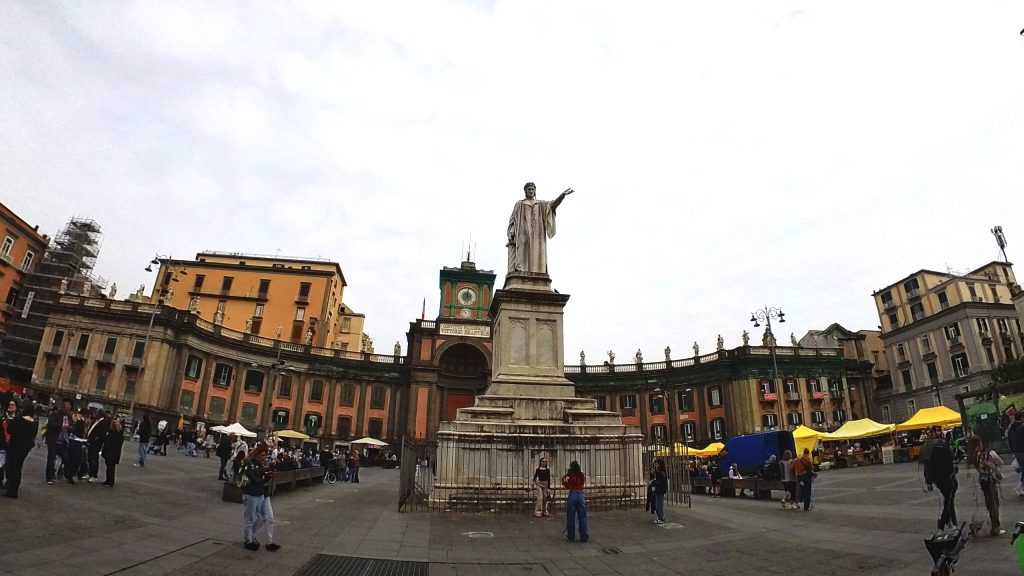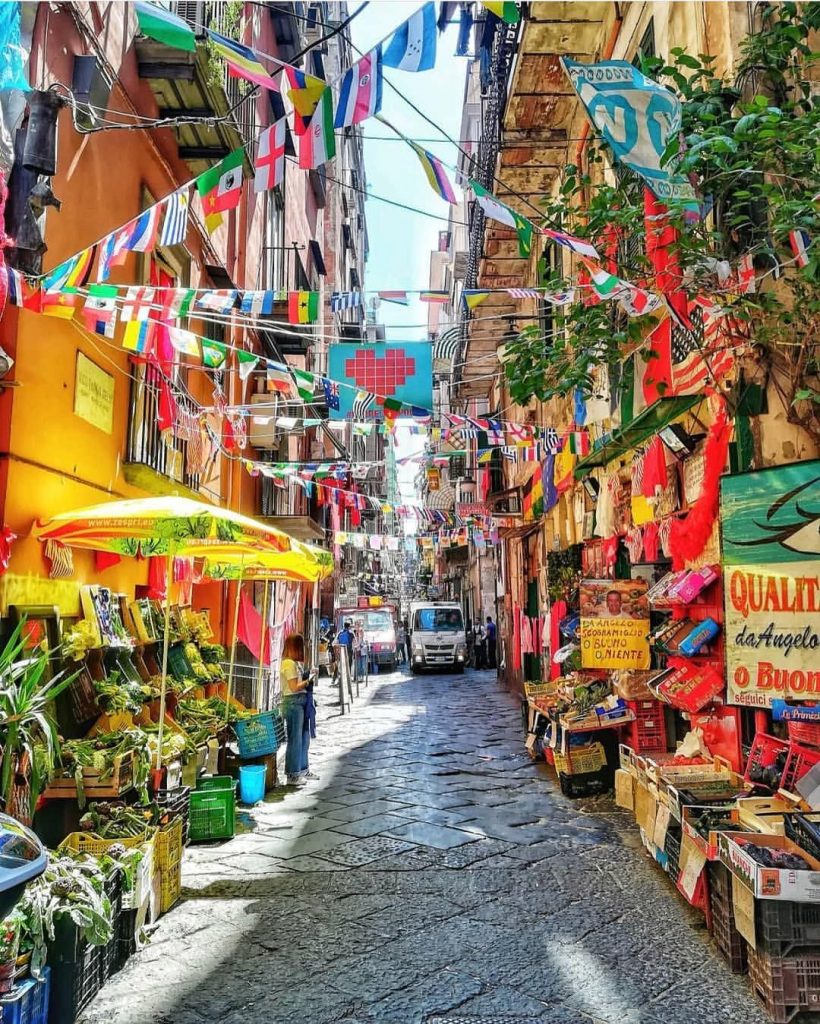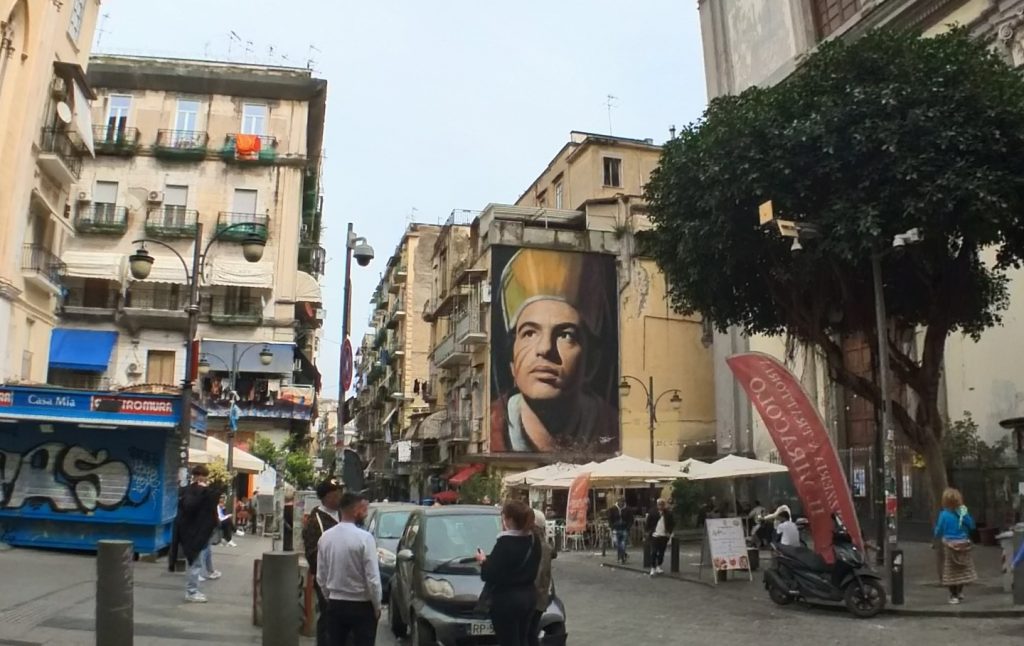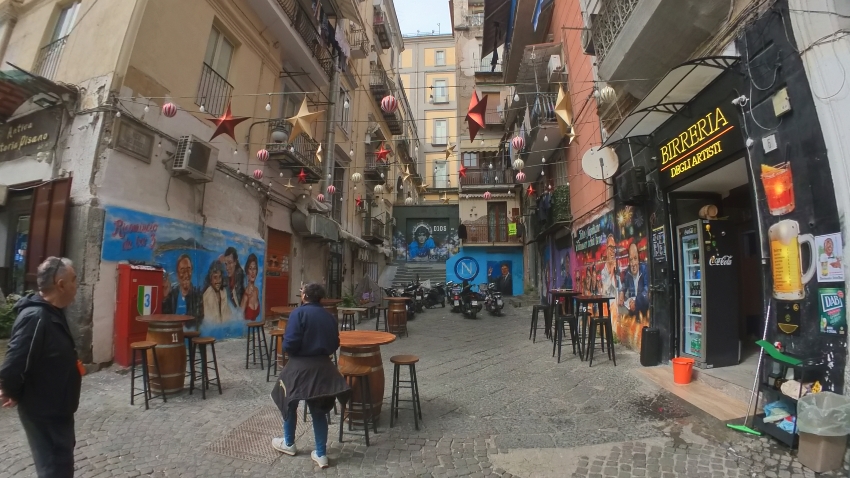Remember that all our blog post are hand made by real locals, trying to help tourist and people living in Italy to enjoy the most of everything
A Different Kind of European City

If you’ve traveled to major European cities, you’ve likely noticed a pattern: pristine historic centers transformed into tourist wonderlands, where local life has been pushed to the periphery. From Barcelona’s Gothic Quarter to Prague’s Old Town, these once-authentic cores now host the same international chains, souvenir shops, and overpriced restaurants.
Naples shatters this pattern completely.
First of all, it is the biggest historic centre of all Europe
Unlike its northern Italian counterparts or other European capitals, Naples stubbornly refuses to sanitize its historic center. Here, the chaotic, pulsating heart of the city remains defiantly authentic. In a striking reversal of the typical European urban layout, Naples keeps its working-class neighborhoods right in the city center, while its more affluent districts spread across the surrounding hills.
This unique urban arrangement isn’t by accident – it’s a testament to Naples’ rebellious spirit and the tenacious grip its people maintain on their cultural identity. While the wealthy citizens of Florence, Rome, and Milan gentrified their historic centers decades ago, Neapolitans created an entirely different social geography.
Naples’ unique neighborhood structure – with working-class districts in the historic center and affluent areas in the surrounding hills – creates an urban experience unlike any other European city. This geographical arrangement preserves the authentic character that makes Naples so captivating.
As you explore these diverse districts, you’ll encounter a city of stark contrasts and beautiful contradictions. From the narrow alleys of the Spanish Quarters to the panoramic views of Posillipo, each neighborhood reveals a different facet of Neapolitan identity.
What’s most remarkable is how Naples has managed to evolve without losing its soul. Areas that once had dubious reputations now welcome visitors, but they do so on their own terms – maintaining their distinctive character, traditions, and community spirit.

In Naples, the most “real” neighborhoods – the Quartieri Spagnoli (Spanish Quarters), Sanità, and Forcella – occupy prime real estate in the historic center. Meanwhile, the city’s upper-class citizens have traditionally retreated to the breezy heights of Vomero and Posillipo or the elegant seaside district of Chiaia.
This distinctive arrangement means that visitors experience the authentic heartbeat of Naples the moment they set foot in the centro storico – no need to venture into distant suburbs to find “the real Naples.” It’s all right there, simmering in plain sight.
Let’s explore these fascinating neighborhoods that make Naples truly unique among European cities.
The Historic Center: Where Past and Present Collide
Quartieri Spagnoli (Spanish Quarters)
Location: Just west of Via Toledo, extending uphill
Vibe: Formerly notorious, now trendy but still authentic
What to expect: Narrow alleys covered in laundry, vibrant street life, small businesses

Once established by Spanish troops in the 16th century (hence the name), the Quartieri Spagnoli spent decades with a reputation so dubious that even locals would warn against visiting. When I was growing up, these narrow streets were known as a reliable place to find weed in Naples and other illicit activities, with locals cautiously navigating its grid-like alleys.
Today, the Spanish Quarters have undergone a remarkable transformation without losing their soul. The same families who once survived through various underground economies now operate bustling friggitorie (fried food stalls), craft workshops, and small B&Bs. What’s fascinating is how this evolution happened organically, without the forced gentrification seen in other cities.
Neapolitan changed the city by themself
Walking through these densely packed streets today, you’ll witness the neighborhood’s signature features: laundry strung between buildings, residents chatting from balconies, and walls adorned with murals of Diego Maradona (the football legend who achieved saint-like status in Naples). The atmosphere is electric, especially around lunchtime when the scent of ragù and fried pizza saturates the air.
Don’t miss:
- Complesso Monumentale di Santa Maria dello Sputo for a peaceful escape
- The famous Maradona mural at Piazzetta Maradona
- The Toledo Metro Station at the neighborhood’s eastern entrance – consistently ranked among the world’s most beautiful subway stations
- A lunch at Tandem for their legendary ragù
Sanità
Location: Just north of the archaeological museum
Vibe: Working-class resilience with baroque splendor
What to expect: Architectural treasures amid everyday Neapolitan life
If the Spanish Quarters have been “discovered,” Sanità represents Naples’ authentic heart still beating at its own rhythm. Geographically separated from the rest of the city center by a bridge, this isolation allowed Sanità to develop its distinct character – and reputation.
Just a decade ago, this was another area where visitors might come looking for weed in Naples or other contraband while locals hurried through. The neighborhood’s name ironically means “health,” though it was historically anything but healthy – built over ancient Greek and Roman cemeteries, it later became home to the city’s plague victims.
Today, Sanità is experiencing a renaissance, but unlike the Spanish Quarters, it’s still early in its transformation. The neighborhood offers a remarkable juxtaposition of breathtaking baroque churches alongside humble homes, street vendors, and bustling markets.
Sanità was once home to Totò, a beloved Italian actor and comedian, and his presence is still felt everywhere. The district maintains a strong sense of community, with generations of families living in the same buildings and local characters who become part of your experience.
Don’t miss:
- Palazzo dello Spagnolo with its magnificent double-ramp staircase
- The underground Catacombs of San Gennaro and San Gaudioso
- Pasticceria Poppella for their famous “fiocco di neve” pastry
- Local artisans crafting nativity scene figures, a Neapolitan tradition
Forcella

Location: East of Via Duomo
Vibe: Raw, unpolished Naples with a complex reputation
What to expect: Ancient streets, remarkable churches, authentic food
Forcella (meaning “fork” in Italian) takes its name from the Y-shaped road that once divided the neighborhood. This compact district has perhaps the most complex reputation of all Naples neighborhoods – historically associated with Camorra (the local mafia) activity, it remained off-limits to tourism for decades.
When locals wanted to find weed in Naples or other illicit goods in the past, Forcella was often mentioned in whispers. Today, while still rough around the edges, Forcella offers adventurous travelers a glimpse of Naples at its most unfiltered.
The narrow streets hide ancient churches with priceless artwork, family-run restaurants serving dishes you won’t find in more touristy areas, and a slice of daily Neapolitan life that feels untouched by outside influence. This is where you’ll hear the authentic Neapolitan dialect spoken at full volume and experience the city’s infamous traffic chaos in all its glory.
Don’t miss:
- The ancient Roman ruins of Carminiello ai Mannesi
- Church of San Giorgio Maggiore with its baroque interior
- Da Michele, possibly the most famous pizzeria in the world
- The vibrant Mercato di Forcella for local produce and street food

The Affluent Districts: Naples’ Elegant Side
Vomero
Location: Hilltop district accessible by funicular railways or metro trains
Vibe: Sophisticated, residential, with spectacular views
What to expect: Wide boulevards, upscale shopping, cleaner air
Unlike the chaotic energy of the historic center, Vomero offers an entirely different vision of Naples. Perched atop a hill overlooking the bay, this affluent residential district developed in the late 19th century as wealthy Neapolitans sought escape from the crowded conditions below.
The contrast with the historic center couldn’t be more striking – Vomero features wide, tree-lined streets, elegant apartment buildings, and a distinctly more ordered atmosphere. While tourists once rarely ventured here, the district has become increasingly popular for its spectacular views and glimpse into upper-class Neapolitan life.
Vomero offers excellent shopping along Via Scarlatti and Via Luca Giordano, plus some of the city’s best pasticcerie and gelaterias. The neighborhood is home to two important landmarks: Castel Sant’Elmo and the Certosa di San Martino, both offering panoramic views that will leave you breathless.
Don’t miss:
- Sunset views from the belvedere near Castel Sant’Elmo
- Villa Floridiana and its beautiful gardens
- A shopping spree along Via Scarlatti
- Gay-Odin chocolate shop for some of the best Naples’ best artisanal chocolates
Posillipo
Location: Western coastal hill
Vibe: Exclusive, peaceful, spectacular sea views
What to expect: Roman ruins, hidden beaches, luxury villas
If Vomero represents upper-middle-class Naples, Posillipo is where the city’s genuine elite reside. This verdant hill extending into the sea has attracted the wealthy since Roman times, when Emperor Augustus’ friend Vedius Pollio built his magnificent villa here (the name Posillipo comes from the Greek “Pausilypon” meaning “respite from worry”).
Posillipo offers breathtaking views across the Bay of Naples toward Vesuvius, Capri, and Sorrento. The district feels worlds away from the frenetic energy of the historic center, with its winding roads, gated villas, and sense of exclusivity.
While parts of Posillipo remain inaccessible behind private gates, visitors can explore remarkable sites like the Parco Archeologico del Pausilypon with its ancient Roman theater, or take a boat trip to see the ruins partially submerged by the sea. The neighborhood also boasts some of Naples’ best restaurants, where you can dine overlooking the Mediterranean.
Don’t miss:
- Parco Virgiliano for the absolute best views in Naples
- Villa Rosebery, the Italian President’s Neapolitan residence (open occasionally to the public)
- The underwater archaeological park at Gaiola
- Sunset aperitivo at one of the seaside restaurants
Chiaia
Location: Seafront district between Mergellina and Piazza del Plebiscito
Vibe: Elegant, fashion-conscious, cosmopolitan
What to expect: Designer boutiques, historic cafes, beautiful architecture
Chiaia represents Naples at its most sophisticated and international. This seafront district, with its curved promenade tracing the bay, has long been the city’s elegant salon – a place to see and be seen. While still distinctly Neapolitan, Chiaia feels more connected to Milan or Paris than to the nearby Spanish Quarters.
The neighborhood centers around Via dei Mille and Via Filangieri, lined with designer boutiques, historic cafes, and elegant buildings. The Villa Comunale, a long public garden running parallel to the sea, offers a pleasant green space for strolling as the waves crash nearby.
Chiaia is home to some of Naples’ most revered culinary institutions, from historic cafes like Gran Caffè Gambrinus to innovative contemporary restaurants. While not as rich in ancient history as other districts, Chiaia compensates with refined 19th-century charm and seaside beauty.
Don’t miss:
- Piazza dei Martiri, the elegant square with its marble column and lion statues
- Shopping along Via Calabritto and Via Filangieri
- The Lungomare (seafront promenade) for sunset strolls
- Pizzeria Brandi, where the Margherita pizza was allegedly invented
The Transformation of Naples’ Neighborhoods
What makes Naples’ neighborhoods so fascinating in 2025 is witnessing their ongoing evolution. Unlike other European cities where gentrification completely displaces local communities, Naples has found a more organic path forward.
Take the Spanish Quarters, for example. Ten years ago, locals would advise against visiting, and it was known primarily as a place to find weed in Naples or other shady dealings. Today, those same narrow streets host trendy bars and Airbnbs, but the change has largely benefited original residents rather than forcing them out.
The same families who once relied on underground economies now run successful restaurants, shops, and guest houses. Former dealers now flip perfect pizzas fritta for the Instagram crowd. This transformation has preserved the neighborhood’s authentic character while improving safety and bringing new opportunities.
Similarly, Sanità is experiencing a renaissance driven by local entrepreneurs rather than outside developers. Community initiatives have reclaimed public spaces, restored artistic treasures, and created new businesses that employ local youth. The neighborhood’s famous catacombs now draw thousands of visitors, bringing tourist euros directly into an area that desperately needed economic opportunities.
This distinctly Neapolitan approach to urban renewal – chaotic, organic, and community-centered – offers a fascinating alternative to the sterilized gentrification seen elsewhere in Europe.
Tips for Exploring Naples’ Neighborhoods
Safety: While Naples’ formerly dangerous neighborhoods have become much safer, common-sense precautions still apply. Keep valuables secure, be aware of your surroundings after dark, and trust your instincts.
Transportation: The historic center is best explored on foot despite the challenging cobblestones. For Vomero and Posillipo, use the funicular railways or metro Line 1. Chiaia is now connected to the historic center via the new Line 6.
Timing: Neighborhoods like Spanish Quarters and Sanità buzz with energy in the morning and early evening but can seem deserted during the afternoon riposo (Italian siesta). Plan accordingly.
Accommodations: For first-time visitors, staying in Chiaia offers a good balance of accessibility and comfort. More adventurous travelers will find excellent value and authentic experiences in the Spanish Quarters or the historic center near Via Tribunali.
Language: While English is increasingly common in tourist areas, learning a few Neapolitan phrases will enhance your experience, especially in Sanità and Forcella.
In a world of increasingly homogenized urban experiences, Naples’ neighborhoods offer something increasingly rare: authenticity. Come discover them for yourself.
⚠️ Disclaimer ⚠️
The information provided in this article is for informational purposes only. While we strive to provide accurate and up-to-date insights about Naples’ neighborhoods, travelers should always exercise personal judgment when exploring unfamiliar areas. Cannabis remains illegal for recreational use in Italy, and we do not endorse any illegal activities.


Leave a Reply